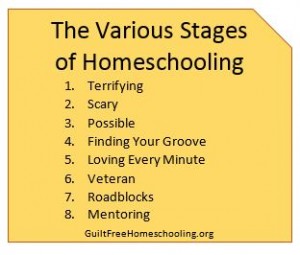You may already have many basic supplies leftover from last year—notebooks, pencils, crayons, colored pencils, and so on. If your current stash is limited, you can certainly purchase more, but what you will need at home is not nearly as extensive as the list schools send out each year. Include a backpack (again, the one from last year may be adequate) if your student will be carrying his supplies to a sitter or Grandma’s while you go to work.
Our favorite curriculum items are ones we have recommended time and time again—without any compensation from the publishers, so you can trust that we really liked these. We did use many other products, but these have remained outstanding favorites.
Alpha-Phonics teaches reading just as well as the super-pricey programs, but for 1/10th of the cost. The book is not loaded with childish drawings, as some others are. If you find you need flashcards or other manipulatives, you can easily make some yourself with index cards. Let your student help! We supplemented this with beginning reading books that used words similar to those in the lessons, and had no need of other materials offered.
At Last! A Reading Method for Every Child! It’s a hard-to-find book, but it does contain a 2-week crash course in remedial phonics, which was ideal for my formerly public-schooled child with reading deficiencies. (This book has been updated since I first bought it; the chapter for the crash course is now called “Uniform Approach.”)
Getty-Dubay Italic Handwriting Series was my favorite for very simple but elegant handwriting that, incidentally, converts to cursive with few changes and little difficulty for students. I used these workbooks with my children and did the program myself to improve my own poor handwriting, so I can recommend it highly. Book E covers both a printed manuscript and cursive handwriting—the suggested place to begin if you already know basic handwriting. I used a plain spiral notebook for copying my exercises, leaving the workbook for my student and giving myself plenty of room to practice.
Miquon Math is an excellent program, designed to be used in grades 1-3, but is so thorough that students can step directly from it into Saxon 6/5 (6th grade) without difficulty. The set of 6 workbooks, normally done 2 per year, step quickly into complex math, but in a way that even 6-year-olds can understand. Miquon teaches adding and subtracting, then moves into multiplication as a logical extension of addition. Before the series is finished, the student is graphing rectangular coordinates with complete confidence! Grade 1 uses the Orange Book and Red Book; grade 2 uses the Blue Book and Green Book; grade 3 uses the Yellow Book and Purple Book. The Lab Sheet Annotations book is the teacher’s guide and answer key, and is a must for teaching this material, along with a basic set of Cuisenaire Rods (wooden or plastic sticks in 1-10 unit sizes; the wooden ones sound better when falling off the table). The student workbooks are printed on newsprint in colored ink, but are relatively free of kiddie pictures, other than cartoon-style illustrations necessary to the lessons. Miquon is my favorite program of everything we used!
Key to Fractions (also Decimals, Percents, and Measurements) series of 3-4 workbooks are excellent for any students who may be struggling with the concepts of fractions, decimals, percents, or measurements (we used each of those sets with wonderful results). Their Key to Algebra and Key to Geometry full-year series also break down scary math concepts into do-able steps and make the subjects simple to understand. All workbooks are thin, comic-book-style, and completely non-threatening and un-intimidating for math-phobic students. Answer keys are available and great time-savers. Key to… workbooks are definitely my second-most favorite program.
Easy Grammar is no-nonsense, straight-forward, and easy. We used this program in its early stages, when there was only one level, simply called Easy Grammar. Its treatment of grammatical rules is simplified by learning prepositions first, then eliminating all prepositional phrases from a sentence, to easily identify the other parts of speech. Easy Grammar was a godsend to my public-school-refugee student, whose previous classroom experiences were built on presenting incorrect examples every day, without teaching correct examples first. Easy Grammar taught the correct rules very plainly and simply. We loved it!
Saxon Math uses continuous review to keep concepts fresh in students’ minds, rather than working on a single concept per chapter, as is done by most math textbooks. The “homeschool kit” includes a test booklet, with instructions to give a test after every 5th lesson, but even those testing questions are reviewing material covered 5-10 lessons ago. (Test #1 covers Lessons 1-5, but is given after Lesson 10, and so on.) As I recall, the tests were 20 questions each, a few less than daily problem sets. We used the tests as our method of review at the beginning of the year. The student did test after test, as many as they desired each day, as long as they could get each problem correct. A perfect score allowed them to proceed to the next test. If any mistakes were made, they were analyzed for cause: hasty errors or misunderstanding. If the student could rework a hasty error and get the correct answer, he moved on as with a perfect score. If the cause of mistakes was misunderstanding, that indicated a lesson that needed more work, and we tracked back to the group of 5 lessons covered by that test, as the place for that student to begin math lessons for that school year. My students came up with this plan as a challenging way for them to refresh their “math brains” and to skip over the tedious review lessons at the beginning of the books. Since we often had kept working at math over part of the summer (to finish up the past year’s book), their ability to do math rarely waned, and intense review wasn’t needed. My students also presented a logical argument against taking regular math tests, since Saxon already “tests” on a daily basis through their continual reviewing of previous concepts. Not testing became a great time-saver, which allowed us to keep moving forward with daily lessons. An answer key is included with the homeschool kit, but it lists only the final answer to problems. The Solutions Manual is valuable for showing the step-by-step solutions to more advanced problems. We bought the Solutions Manual for Algebra 2 and Advanced Math—there wasn’t one available yet for Algebra 1, when we used that book. Other Saxon Math textbooks we used were Saxon 6/5, Saxon 7/6, and Algebra ½. (For levels 5/4, 6/5, 7/6, and 8/7, the 1st number is the typical grade level; the second number is for exceptional students in that grade—so 5/4 is for most 5th graders, or exceptional 4th graders.)
Biographies, including historical figures, scientists, inventors, and artists, gave my students a look at the more personal side of history, science, and other subjects. We could find interesting biographies at the public library (in both the children’s and adults’ sections); biographical movies were another good source for seeing the human side of topics that can sometimes be harder to delve into. Exploring one person’s life story gave my students a desire to know more about others, drawing them into the topics more deeply than ordinary textbooks would have done. (My test for finding an interesting book is to read the first paragraph. If I have to restart several times and force myself to get through it, I put that book down and try another one. If I find myself in the middle of the second paragraph or suddenly turning the page, engrossed in the story, I know that I will enjoy reading the whole book.)
“Uncle Eric” Books by Richard Maybury are an often-overlooked series of 11 books that deal with everything from history to economics to government to politics. These books offer a unique perspective that Americans usually don’t see and deal with root causes of worldwide conflicts, rather than just the surface view. The tricky concepts of economics and world governments are clearly explained for middle school to high school level. We used the following titles, but there are several more that have been added to the series:
- Whatever Happened to Penny Candy?
- Whatever Happened to Justice?
- Are You Liberal, Conservative, or Confused?
- Evaluating Books: What Would Thomas Jefferson Think About This
- Ancient Rome: How It Affects You Today
- The Clipper Ship Strategy
- The Thousand Year War in the Mideast
The Elements of Clear Thinking by William F. McCart is a high school level program for teaching Accurate Communication, Critical Reading, and Sound Reasoning. Simply put, how to say what you mean and how to analyze what an author meant and whether or not he succeeded. This set is 3 thin workbooks, but don’t be fooled into thinking students will zip through them. The 3rd book contains some especially weighty passages to read and analyze. (I had to buy the answer keys.) When my second student struggled with some of the more difficult reading selections, we opted for finding our own reading materials at the library, and I wrote questions for those, similar to what was used in the workbook. However, the section on “Fallacies of Reasoning” is excellent and redeemed any issues we had with other parts. This series was excellent preparation for my students’ future college classes, for in-class discussions, reading assignments, and writing papers.
Materials in your students’ grade levels may be ordered online from: Amazon, Rainbow Resource Center, Christian Book Distributors, and many other reputable suppliers.
Public libraries are an excellent source for reading material for all topics, but some may have limited access during your year of Emergency Homeschooling.
Wonderful supplemental activities can be found at Timberdoodle and Miller Pads and Paper, as well as the hands-on learning supplies available at Target’s Dollar Spot, Dollar Tree’s educational supplies, and other dollar-stores, bookstores, and office supply stores.
Supplemental learning aids can be as common as the play money from a Monopoly game, the letter tiles from a Scrabble game, and a deck of playing cards (using Ace-10 becomes a math deck for all sorts of practice). For more advanced learning tools, hit up the grocery aisles for sugar cubes and alphabet macaroni (use it dry and uncooked), but keep these on a cookie sheet to minimize any mess.
Start with the “3 R’s” of reading, ‘riting, and ‘rithmetic for teaching your students the most basic skills. For history and science materials, look at whatever seems to fit your student’s interests and grade level. Some students may enjoy the all-in-one-workbooks, like What Your Second Grader Needs to Know, and other students will prefer separate workbooks for each subject. Be aware that online learning programs and some pre-packaged learning programs will require the student to answer every question on every page of every book. If your student would be overly burdened by that, choose a less aggressive approach.
You know your children best, so trust your instincts or discuss with them what is available and give them an opportunity to provide some input on what seems more appealing to them. For this emergency year, anything-at-all will be far better than nothing-whatsoever, so don’t judge your efforts too harshly.
Other titles in this series:
- Emergency Homeschooling: You CAN Do This!
- Emergency Homeschooling: FAQ’s
- Emergency Homeschooling: Benefits






 Guilt-Free Homeschooling is the creation of Carolyn Morrison and her daughter, Jennifer Leonhard. After serious disappointments with public school, Carolyn spent the next 11 years homeschooling her two children, from elementary to high school graduation and college admission. Refusing to force new homeschooling families to re-invent the wheel, Carolyn and Jennifer now share their encouragement, support, tips, and tricks, filling their blog with "all the answers we were looking for as a new-to-homeschooling family" and making this website a valuable resource for parents, not just a daily journal. Guilt-Free Homeschooling -- Equipping Parents for Homeschooling Success!
Guilt-Free Homeschooling is the creation of Carolyn Morrison and her daughter, Jennifer Leonhard. After serious disappointments with public school, Carolyn spent the next 11 years homeschooling her two children, from elementary to high school graduation and college admission. Refusing to force new homeschooling families to re-invent the wheel, Carolyn and Jennifer now share their encouragement, support, tips, and tricks, filling their blog with "all the answers we were looking for as a new-to-homeschooling family" and making this website a valuable resource for parents, not just a daily journal. Guilt-Free Homeschooling -- Equipping Parents for Homeschooling Success!

Recent Comments